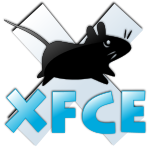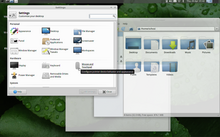Xfce
| Xfce
|
|
|---|---|

|
|
 Xfce 4.12 |
|
| Basic data
|
|
| developer | Acknowledgments |
| Publishing year | 1996 |
| Current version |
4.14 ( August 12, 2019 ) |
| operating system | unixoid system |
| programming language | C. |
| category | Desktop environment |
| License | GNU General Public License , GNU Lesser General Public License , BSD License |
| German speaking | Yes |
| xfce.org | |
Xfce is a modular , free desktop environment for Unix and Unix -like operating systems . It is published as free software under the GPL , LGPL and 2-clause BSD license . According to a survey by LinuxQuestions.org, Xfce is the second most widespread desktop environment on the Linux desktop after KDE (as of 2017).
Like Gnome , LXDE and ROX, Xfce is based on the GUI toolkit GTK + , currently supports over 40 languages and its appearance can be adapted using themes . Since Xfce 4 conforms to the freedesktop.org standards , it can also handle Gnome and KDE programs - and vice versa.
Surname
The name Xfce originally stood for XForms Common Environment ("General XForms Environment"), since Xfce was initially based on the XForms GUI toolkit . Since newer versions of Xfce are no longer based on XForms, the acronym is now irrelevant. The name is pronounced as single letters in German or English: [ ɛks ɛf siː iː ].
history
The development of Xfce as a panel for FVWM was started in 1996 by Olivier Fourdan. Initially, Xfce was based on the XForms GUI toolkit .
Version 2.0, which was released in 1997, was the first to include the xfwm window manager specially developed for Xfce .
In 1999, Version 3 was released, a version rewritten using GTK + . Up to this version, Xfce was based on the Common Desktop Environment (CDE), which came with many commercial Unix operating systems.
Version 4.0 is dated September 2003, with almost the entire architecture of Xfce being changed. The visual appearance was improved and the modularity increased. Since this version there is also a framework for developing new Xfce applications available.
With version 4.4 of Xfce, which was presented on January 21, 2007 after two years of development, support for the new composite functions of X.Org , such as shadows and real transparency, was introduced (although version 4.2 already partially supported these). The support of icons on the desktop and the leafpad- based text editor Mousepad are also new . The previous file manager xffm has been replaced by Thunar .
Version 4.6 was released on February 27, 2009. This brought as an innovation z. B. with Xfconf a configuration system based on D-Bus .
Version 4.8 was released on January 16, 2011 after two years of development. It has been heavily adapted to current desktop frameworks so that ThunarVFS and HAL are no longer required through the consistent use of GIO, udev , ConsoleKit and PolicyKit . The Thunar file manager now also supports native access to SFTP , SMB and FTP shares. There are also a number of other minor innovations.
Version 4.10 was released on April 28, 2012. With this version, windows can be tiled and applications or files on the desktop can be opened with just a click of the mouse. The bar can now be displayed vertically and the desktop can display thumbnails . A new MIME type editor makes it easier to assign applications to open files, and the settings editor has been expanded. Another change is that the application finder has been completely rewritten, which combines the xfce4-appfinder and xfrun4 packages with their functionalities.
Version 4.12 was released on February 28, 2015 after two years and ten months of development. With this version, the switch to GTK + 3 was advanced. The window manager is now customizable and the tiling and snap function has been improved. From version 4.12 the panel hides when a window is pulled up against it. A revision also took place in the support of multiple monitors; a separate theme can also be used for each desktop. Thunar now supports several tabs, individual shortcuts and a graphic display of the free memory with a bar. As of version 4.12, the power management also supports logind and UPower .
Version 4.14 was released on August 12, 2019 and is based on GTK + 3.
Components
In addition to the core components (session management, program bar, etc.), the Xfce project also includes the following programs:
- Application Finder : Allows you to find and run applications, and provides information about installed programs.
- Midori : Aweb browser basedon WebKit GTK +
- Mixer: A volume control for the notification field (systray) in the program bar (panel)
- Mousepad: A leafpad based text editor
- Orage: A simple calendar with a reminder function that uses the iCalendar format
- Ristretto: A simple and fast picture viewer
- Terminal: A terminal emulator tailored to the Xfce work environment
- Thunar : A slim and fast file manager thatcan be expandedwith plug-ins
- Xfburn : A CD and DVD burning program based on the libburnia project
- xfce4-screensaver: screen saver
- catfish: file / desktop search
There are also the following community applications from Xfce Goodies :
- Eatmonkey: A frontend for aria2 ( download manager )
- Gigolo: A GIO based viewer for remote networks
- Parole : A multimedia player based on GStreamer
- Task manager: A process management / activity display
- Xfbib: A slim BibTeX editor
- xfce4-clipman: A clipboard manager
In addition, several plugins to expand the above components.
Distributions with Xfce
In the vast majority of Linux distributions and BSD derivatives, Xfce can be installed later if it is not already the standard environment, as in the ones listed below, or is offered as an option during installation:
- Antergos
- aptosid
- Arch Linux
- Debian (businesscard, netinst and DVD)
- Devuan
- Dragora
- dyne: bolic
- Fedora (Xfce Spin)
- GalliumOS
- Gentoo Linux
- Kali Linux
- Linux Mint (XFCE Community Edition and Linux Mint Debian Edition (LMDE))
- Manjaro
- MX Linux
- Mythbuntu
- NuTyX
- openSUSE (Xfce Live CD)
- Parabola GNU / Linux-libre
- Pardus
- Siduction (XFCE Live CD & Desktop)
- Slackware
- SystemRescueCd
- Void
- Xubuntu
- Yellow Dog Linux
- Zenwalk Linux (Standard Edition, Live Edition)
Other Linux distributions that supported Xfce have since been discontinued, such as Dreamlinux (2012) and Foresight Linux (2015).
Web links
- Official website
- Xfce Goodies Project - additional tools related to Xfce
- documentation
- Wiki
Individual evidence
- ↑ Xfce creator talks Linux, Moblin, netbooks and open-source . (English).
- ↑ Xfce 4.14 released . (English).
- ↑ Steven J. Vaughan-Nichols: The most popular Linux desktop programs are… In: ZDNet . ( zdnet.com [accessed April 29, 2018]).
- ↑ a b c de: faq. In: Xfce Wiki. Retrieved March 11, 2017 .
- ↑ Innovations through XFCE 4.8. In: XFCE homepage. January 16, 2011, accessed March 1, 2015 .
- ↑ Xfce 4.10 released. In: XFCE homepage. April 28, 2012, accessed March 1, 2015 .
- ↑ Xfce 4.12 released. In: XFCE Homepage. February 28, 2015, accessed March 1, 2015 .
- ↑ Jörg Thoma: Xfce 4.12 is finally finished. In: Golem.de. March 1, 2015, accessed March 1, 2015 .
- ↑ https://docs.xfce.org/apps/catfish/start
- ↑ Xfce 4.14 released. Retrieved on August 15, 2019 : "Catfish file search is like an old friend for most Xfce users - now it's officially part of Xfce!"
- ↑ aptosid.de - This website is for sale! - aptosid Resources and Information. Accessed December 2, 2018 .
- ↑ archlinux.de. Retrieved December 2, 2018 .
- ↑ # 511287 - debian-installer: Should have a task for installing KDE or XFCE instead of Gnome - Debian Bug report logs. Retrieved December 2, 2018 .
- ↑ Fedora Xfce Desktop. Accessed December 2, 2018 .
- ↑ GalliumOS - A fast and lightweight Linux distro for ChromeOS devices. Retrieved May 13, 2017 .
- ^ Project: Xfce - Gentoo Wiki. Accessed December 2, 2018 .
- ↑ Community Editions of Linux Mint ( Memento from February 10, 2010 in the Internet Archive )
- ↑ Manjaro Linux Forum Index. Retrieved December 2, 2018 .
- ↑ Project page MX Linux
- ↑ Mythbuntu project page
- ↑ OpenSUSE project page
- ↑ https://www.pardus.org.tr/surumler/
- ↑ XFCE 4.10 for siduction. In: news.siduction.org. Retrieved December 2, 2018 .
- ^ The Xubuntu community: Xubuntu. Retrieved December 2, 2018 (American English).
- ↑ Zenwalk GNU Linux. Accessed December 2, 2018 .
